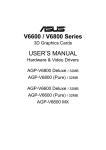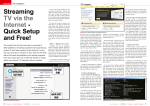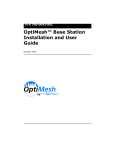Download Buddy B-680 Lite User Manual
Transcript
THINSOFT PTE LTD 23, Tai Seng Drive, Singapore 535224 - Phone (65) 6289-7308 www.thinsoftinc.com Buddy B-680 Lite User Manual Document Version 1.6 Copyright ThinSoft Pte Ltd 2003 1 Buddy B-680 Lite User Manual Copyright 2003 ThinSoft Pte Ltd. All rights reserved. ThinSoft Pte Ltd 23 Tai Seng Drive Singapore 535224 Fax: (65) 6289-7308 This document is being furnished by ThinSoft Pte Ltd for information purpose only to licensed users of the Buddy® software product. Efforts are made to ensure the accuracy of the information presented, but is subject to change without prior notice. Changes, if any, will be incorporated in future releases. Buddy® are the registered trademark of ThinSoft Pte Ltd. Other brand and product names are the trademarks or registered trademarks of the respective holders. Microsoft is a registered trademark and Windows, Windows 2000, Windows XP, are the registered trademark of the Microsoft Corporation. IBM and PC/AT are the registered trademarks of International Business Machines Corporation. No part of this document may be reproduced for commercial purposes unless prior permission is obtained from the copyright holder. Visit our Web Site at http://www.thinsoftinc.com 2 Table of Contents 1. The Buddy B-680 Lite kit 2. Installation Overview 3. Hardware Guidelines 4. Buddy B-680 Lite Installation 4.1. Installing the PCI Video Adapter 4.1.1. Installing the Video Drivers for Windows XP and Windows 2000 Professional 4.1.2. Enabling the Multiple Display Monitor feature under Windows XP and Windows 2000 Professional 4.2. Installing the PS/2 Keyboard, PS/2 Mouse and USB-to-PS/2 Converter 5. Introduction to Buddy software 5.1. Installing the Buddy Software 5.2. Configuring the Buddy Station Using Configuration Wizard 5.3. Configuring the Buddy Station Manually 5.4. Logging onto the station automatically under Windows 2000 Professional 5.5. Logging onto the station automatically under Windows XP Professional or Home Edition 5.6. Using the Locator Buttons 5.6.1. Keyboard/Mouse Locator 5.6.2. Sound Device Locator 5.7. Using the Buddy Control Center 5.7.1. Station Mode 5.7.2. User Mode 5.7.3. Message Mode 5.7.4. Eventlog Mode 5.7.5. Menu Options 6. Logging onto the Computer for the First Time 7. Logging onto the Computer as a Different User 8. Shutting Down Windows in Windows 2000 Professional 9. Shutting Down Windows in Windows XP Professional Edition 10. Sharing the Internet Connection in Windows 2000 Professional 10.1. Simultaneous Independent Sharing 10.2. Setting up Dial-up Connection 11. Sharing the Internet Connection in Windows XP Professional or 3 5 5 6 7 7 9 10 13 15 15 17 19 22 25 27 27 27 28 28 29 30 31 31 35 36 37 38 39 39 39 40 Home Edition 11.1. Simultaneous Independent Sharing 11.2. Setting up Dial-up Connection 12. Adding Software or Hardware 13. Problem Solving 13.1. General Guidelines 14. Updating Buddy 15. Technical Support 4 40 40 41 42 42 43 44 Congratulations on your purchase of the Buddy B-680 Lite kit, with which you can add an additional PC workstation to your existing PC. 1. The Buddy B-680 Lite kit i) ii) iii) iv) v) Buddy USB-to-PS/2 Converter USB and Video Combo Cable (4.5 meters) Buddy B-680 Utility CD PCI Video Adapter Buddy B-680 Utility Leaflet Make sure all of the above items are included in your Buddy B-680 Lite kit. If anything is missing, please contact the shop where you purchased this kit or your nearest Buddy dealer. Buddy B-680 Lite does not contain hardware to provide sound on the additional workstation. If you wish to have sound, you can supplement the hardware by adding an additional USB speakers to the system. Alternately, you can purchase the B-680 Premium package, which includes a USB audio hub. Please note that the Buddy product line is not compatible with the BeTwin product. If you have already installed BeTwin on the computer, you cannot install Buddy. Please contact [email protected] for additional information. 2. Installation Overview Installation is simple. By following these steps, a two-user system should take less than 20 minutes to set up. Each step is explained in detail in the following pages. Step 1. Install the additional display adapter. Step 2. Connect the PS/2 mouse and keyboard to the PS/2 port of the USB-to-PS/2 Converter. Step 3. Connect the USB port of the USB-to-PS/2 Converter to the USB port on the PC and install the Windows drivers. Check the status of the installed device to ensure that it is correctly installed and test the hardware to ensure that they work properly with Windows. Step 4. Install the Buddy software. Terminology The original computer display, keyboard and mouse are used by one user. This user is called the host. A display, PS/2 mouse and PS/2 keyboard are added for the additional user. This user is called the station. 5 3. Hardware Guidelines CPU A Pentium II 333 MHz processor is the minimum recommendation. For best performance, a Pentium III 450 MHz or faster is suggested. Equivalent AMD processors are also supported. The computer must have at least one available PCI slot and USB port. Minimum • Pentium II 333 MHz Processor Recommended • Pentium III Processor at 450 MHz or faster System Memory 192 Megabytes of memory is the minimum requirement for 2 users. 64 MB of additional memory is recommended for each station. Memory Requirement Minimum • 192 MB (One Host and One Station) Recommended • 256 MB or more Additional User Memory Requirement Minimum • 64 MB per additional Station Recommended • 128MB or more Windows Operating System An IBM PC/ AT or compatible installed with Windows 2000 Professional or Windows XP (Professional or Home Edition) Station Hardware Each Station requires a PCI video card, USB-to-PS/2 Converter (both are included in the Buddy B-680 Lite kit), a SVGA monitor, a PS/2 keyboard and a PS/2 Mouse. If sound is required at the station, USB speakers can be used. Display • • PCI video card SVGA monitor USB-to-PS/2 Converter • • PS/2 Keyboard PS/2 Mouse Speakers • USB connector 6 4. Buddy B-680 Lite Installation Before installing the Buddy software, you must first install the PCI video card, SVGA monitor, USBto-PS/2 Converter, PS/2 mouse and PS/2 keyboard. 4.1. Installing the PCI Video Adapter Step 1. Install the PCI video card. (i) (ii) (iii) (iv) (v) (vi) (vii) Ground yourself by touching the metal chassis of the computer with your fingers. Shut down your computer, switch off the power and unplug it from the electrical outlet. Remove the cover from the computer and locate an available PCI slot. Remove the PCI video card from its anti-static bag, included in the Buddy B-680 Lite kit. Insert the PCI video card into the PCI slot gently until it sits securely into place. Secure the chrome bracket of the PCI video card to the computer. Ensure that no other cards have been accidentally pushed out of their slots. Put the case back onto your computer. Connect one end of the video cable of the supplied USB/VGA combo cable to the VGA connector of the PCI video card and the other end to the second monitor. Plug the power cable back to the electrical outlet before power on your computer. Step 2. If the Host PC has a PCI video add-on card installed, kindly refer to section (i). If the Host PC has an AGP video add-on card installed or integrated in the system motherboard, kindly refer to section (ii). (i) With the PCI video card installed into the Host PC, upon the power-on of the Host PC, boot-up display should appear on the Host PC’s monitor screen. Otherwise, swap the PCI-bus location between the two PCI VGA add-on cards. (ii) With the PCI video card installed into the Host PC, upon the power-on of the Host PC, boot-up display should appear on the Host PC’s monitor screen. Otherwise, go into the Host PC’s BIOS/CMOS Setup to select the option to boot up from AGP VGA first. 7 Eg. The following are examples where different types of PCs have different options to boot from the AGP VGA first. If you are not sure if your PC has such an option, kindly refer to your PC’s documentation or contact your PC Manufacturer’s Technical Support. a. Under the BIOS/CMOS Setup options selection, select “Integrated Peripherals” « “Init Display First”, then select the option “AGP”. b. Under the BIOS/CMOS Setup options selection, select “BIOS Features Setup” « “VGA Boot from”, then select the option “AGP”. c. Under the BIOS/CMOS Setup options selection, select “Integrated Peripherals” « “Init Display First”, then select the option “Enabled”. Step 3. Log in to Windows as the Administrator or User with Administrator’s rights. Step 4. Windows will now detect the new PCI video card and ask for the Windows disk (or driver disk supplied with the PCI video card). In some cases, Windows may detect the new PCI video card and install with the built-in Windows drivers automatically without prompting for the Windows disk. If the Windows drivers do not installed automatically, you will see the InstallShield Wizard for ATI software. Refer to the instructions under the section “Installing the Video Drivers...” to direct you through this portion on the installation. NOTE: The Buddy software should only be installed after the USB-to-PS/2 Converter, Speaker, PS/2 mouse and PS/2 keyboard have been successfully installed and tested. Refer to the instructions under the sections “Installing the PS/2 Keyboard, PS/2 Mouse and USB-to-PS/2 Converter” to direct you through this portion on the installation. 8 4.1.1. Installing the Video Drivers for Windows XP and Windows 2000 Professional Windows will now detect the new PCI video card and prompt for the Windows disk (or driver disk supplied with the PCI video card). Click on the “Cancel” button and follow the instructions below to direct you on the installation of the video drivers. Step 1. Place the Buddy Installation Disk in the CD ROM drive and run setup.exe file from D:\VGA\ATI_Drivers. Assumption: Your CD-ROM drive designator is D: Step 2. You should now see a screen that looks like the one below. Click on the “Next” button to continue. Step 3. Click on the “Yes” button to accept the terms of the License Agreement. Step 4. Click on the “Express” icon to proceed with the installation. 9 Step 5. Once the installation is completed, click on the “Finish” button to restart your computer. 4.1.2. Enabling the Multiple Display Monitor feature under Windows XP and Windows 2000 Professional After successfully installing the PCI video card, by default the Multiple Display Monitor feature is disabled. To enable the Multiple Display Monitor feature of the PCI video card under Windows XP or Windows 2000 Professional, follow the instructions below: Step 1. Go to Windows Control Panel, select the option "Appearance and Themes" under the Category View. Double click on the Display icon and click on the Settings tab. If your Windows Control Panel is in Classic View, double click on the "Display" icon and click on the Settings tab. The next message box to appear will provide the options for enabling the Multiple Display Monitor feature of the PCI video card. 10 Step 2. Click on the second monitor under the "Drag the monitor icons to match the physical arrangement of your monitors" section. Under the "Display" option, it will show the name of the PCI video card. Step 3. To enable the Multiple Display Monitor feature of the PCI video card, check the "Extend my Windows desktop onto this monitor" box. Click on the “Apply” button to apply the settings. 11 Step 4. The monitor connected to the PCI video card should now display the same background (color and pattern) as the Host monitor. Click on the “Identify” button to display a number on the monitors that correspond with the icons shown in the gray box. You should now see the screens that look like the one below. This means that the Multiple Display Monitor feature is working correctly. Click on the “OK” button to quit from the Display Properties. 12 4.2. Installing the PS/2 Keyboard, PS/2 Mouse and USB-to-PS/2 Converter The PCI video card Multiple Display Monitor feature should work as described above before you proceed to install the PS/2 keyboard, PS/2 mouse and USB-to-PS/2 converter. Please be sure to start up Windows before making connection for the first time. Step 1. Start up Windows and log in as the Administrator or User with Administrator’s rights. Closed all active applications. Step 2. Connect the PS/2 keyboard and PS/2 mouse of the additional workstation to the USB-to-PS/2 Converter. Step 3. Connect one end of the USB cable of the supplied USB/VGA combo cable to the USB female connector of the USB-to-PS/2 Converter and the other end to an available USB port on the PC. “Add New Hardware Wizard” will appear and Windows drivers for the PS/2 keyboard and PS/2 mouse will be automatically installed. 13 Step 4. Ensure that the PS/2 keyboard and mouse are correctly installed by checking the status of the installed device. On the Windows desktop, select Start menu button => Settings => Control Panel => System => Hardware => Device Manager. Make sure that the following items are listed in the “Device Manager” window. - “HID Keyboard Device” under “Keyboards”. - “HID-Compliant Mouse” under “Mice and other pointing devices”. Step 5. The PS/2 keyboard can be tested by its effect on the host screen. • • You may verify the working status of the keyboard by pressing the Windows key. The start menu should be displayed. If the keyboard does not work properly, please contact the keyboard manufacturer for assistance. Step 6. The PS/2 mouse can be tested by moving it around and making sure that the mouse pointer (as seen on the monitor) moves in the direction according to the PS/2 mouse movement. • • You may verify the working status of the mouse by moving it. The mouse cursor should move. If the mouse does not work properly, please contact the mouse manufacturer for assistance. 14 5. Introduction to Buddy software Product Description Buddy is the software that allows multiple users to simultaneously and independently share a personal computer running Windows 2000 Professional, Windows XP Professional or Home Edition. Additional video cards, monitors, USB-to-PS/2 Converters, PS/2 mice, PS/2 keyboards and audio speakers can be installed to support up to four additional users. Manufacturer’s Notice The Buddy allows multiple users to simultaneously and independently share the same hardware and software on a single Personal Computer. Some software is licensed for use on a single computer while other software may be licensed for single or multiple users. It is the responsibility of the Buddy purchaser/user to read and comply with the licensing agreements of any software that may be used on a Buddy Station. 5.1. Installing the Buddy Software The Buddy software should only be installed after the hardware has been successfully installed and tested. You are now ready to install the Buddy software. Step 1. • Double-click on the My Computer icon. Double-click on the D: drive icon. Doubleclick on the Buddy folder. Double-click on the Setup icon (the one with the picture of a computer monitor with a box in front of it). Assumption: Your CD-ROM drive designator is D: • Follow the instructions on the screen. • Depending on what Windows options have already been installed, on some systems the Buddy installation may require additional files from the Windows CD so be sure to have the Windows CD handy when installing Buddy. • You should see a screen that looks like the one below during the software installation. Ensure that you have checked the box to run the Buddy Station Configuration Wizard after system reboots. 15 • You will now see a screen that looks like the one below after the Buddy software installation. Click on the “Cancel” button to quit from the InstallShield Wizard (only applicable to Windows 2000 Professional). • You will be prompted to restart your computer. Remove the video driver disk from the CD-ROM drive. Click on the “Yes” button to restart. Your computer will reboot. NOTE: For Windows 2000 Professional systems, your computer will reboot twice. This is normal while Buddy setup is configuring drivers. 16 Step 2. After the system reboots, Configuration Wizard will start to run. • Follow the instruction on the screen. Click OK to proceed with the Configuration Wizard. • Select OK with the Keyboard you wish to use at the respective station. • If prompted, click OK with the Mouse you wish to use at the station. • When the Configuration Wizard is completed, you will be prompted to restart Windows. Click OK. Step 3. After the system reboots, click on Start\Programs\Buddy to launch Buddy Control Center. You should see a screen similar to the one below. Congratulations! You have now fully installed the Buddy software and configured the system. 5.2. Configuring the Buddy Station Using Configuration Wizard If you have not run the Buddy Station Configuration Wizard during the software installation, or if your hardware configuration has changed, you can still run the Configuration Wizard from the Buddy Control Center. Step 1. 17 Double click on the Buddy icon to open Control Center. On the opening screen, click on STATION CONFIGURATION. Step 2. The “Configuration Wizard” feature enables Buddy to auto-assign the USB mice and keyboards to their respective workstations. To auto-assign the USB audio speakers, you need to connect the peripherals (USB mouse, keyboard and speakers) of each workstation to its USB Hub respectively. Click on CONFIGURATION WIZARD. Step 3. You should see a window similar to the one below. Click OK to disable Buddy, reboot the system, and start the Configuration Wizard. 18 Step 4. Click OK to reboot the computer. Step 5. 5.3. • Follow the instruction on the screen. Click OK to proceed with the Configuration Wizard. • Select OK with the Keyboard you wish to use at the respective station. • If prompted, click OK with the Mouse you wish to use at the station. • When the Configuration Wizard is completed, you will be prompted to restart Windows. Click OK. Configuring the Buddy Station Manually For most Buddy installations, running the Configuration Wizard is sufficient for configuring the system. Optionally, you can configure the system manually, or you can use manual configuration to change the hardware assignments created by the Configuration Wizard. To assign the hardware to each workstation manually, 19 Step 1. Double click on the Buddy icon to open Control Center. On the opening screen, click on STATION CONFIGURATION. Step 2. • You should see a window similar to the one below. Click on ADD STATION. • Rename the station or leave the name as “Buddy Station”. You can also change the name later. Click OK 20 • Double click on BUDDY STATION. Click on the “Hardware” option to highlight it. • Click HARDWARE CONFIGURATION. Now select the hardware to be used for station. Note: The display, mouse and keyboard will already have been selected for the station. Each station must have a video card, mouse and keyboard. In addition, audio, joystick or other hardware may be assigned. Note: Some computers equipped with an Intel 810/815 built-in display adapter do NOT have a BIOS option to force that adapter to be the primary display and will need to assign the Intel 810/815 display adapter to the station and use the added PCI adapter as the host display. 21 • To add a piece of hardware to a station, highlight the item by clicking on it in the “Free Hardware” window, then click on the “>>” button. You will then see the hardware appear in the “Station Hardware” window. • To remove a piece of hardware from a station, click on the item in the “Station Hardware” window. Click on the “<<” button, and it will move from the “Station Hardware” to the “Free Hardware” window. • When the station hardware is configured correctly, click on “OK”. This will return you to the “Station Configuration” windows. Click on “OK” again. • When prompted to restart Windows, click on “OK”. USING THE LOCATOR BUTTONS – Please see next page Step 3. After the computer has rebooted • • 5.4. The Buddy station is ready for use. Double click on BUDDY icon to open control center. Logging onto the station automatically under Windows 2000 Professional The “Login Configuration” feature enables user to specify the username and password to use at an individual Buddy station to automatically log on the station. User can also specify a program to run automatically. The Host station is managed using the TweakUI program, downloadable from http://www.microsoft.com/ntworkstation/downloads/PowerToys/Networking/NTTweakUI.asp Step 1. Double click on the Buddy icon to open Control Center. On the opening screen, click on STATION CONFIGURATION. 22 Step 2. You should see a window similar to the one below. Click on LOGIN CONFIGURATION. Step 3. Enter the default username and password to use at an individual Buddy station and deselect the “Always prompt for password” check box. You can also specify a program to run automatically under the Initial Program and Working Directory. Note: The usefulness of setting the working directory will depend on the application being run. 23 Step 4. • On the Windows desktop, select Start menu button => Settings => Control Panel => Users and Passwords. • Click the Advanced tab. • In Secure Boot Settings, deselect the “Require users to press Ctrl+Alt+Delete before logging on” check box. • Reboot the computer. 24 5.5. Logging onto the station automatically under Windows XP Professional or Home Edition The “Login Configuration” feature enables user to specify the username and password to use at an individual Buddy station to automatically log on the station. User can also specify a program to run automatically. The Host station is managed using the TweakUI program, downloadable from http://www.microsoft.com/windowsxp/pro/downloads/powertoys.asp Step 1. Double click on the Buddy icon to open Control Center. On the opening screen, click on STATION CONFIGURATION. Step 2. You should see a window similar to the one below. Click on LOGIN CONFIGURATION. 25 Step 3. Enter the default username and password to use at an individual Buddy station and deselect the “Always prompt for password” check box. You can also specify a program to run automatically under the Initial Program and Working Directory. Note: The usefulness of setting the working directory will depend on the application being run. Step 4. The step is only applicable if your computer is part of a network domain. You must be logged on as an administrator or a member of the Administrators group on the computer in order to complete this procedure. • On the Windows desktop, select Start menu button => Settings => Control Panel => User Accounts. • Click the Advanced tab. • In Secure logon, deselect the “Require users to press Ctrl+Alt+Delete” check box. • Reboot the computer. 26 5.6. Using the Locator Buttons Locator Buttons is only applicable if you are configuring the system manually, or using the manual configuration to change the hardware assignments created by the Configuration Wizard. If there is more than one Buddy station it can be confusing determining which mouse, keyboard or sound device should be assigned to each station. Using the locator buttons can help ease this confusion. Note: To use the locator buttons, Buddy must be disabled. Click on Start/ Program Files/ Buddy/ Options/ Set Configuration/ Deactivate Buddy to disable it. Make sure Buddy is enabled after devices have been assigned to each station. Click on Start/ Program Files/ Buddy/Options/ Set Configuration/ Activate Buddy to enable it. 5.6.1. Keyboard/Mouse Locator To locate a particular peripheral, first click the keyboard/mouse locator button and then press either a key on any USB keyboard or a button on any USB mouse. The display in the Hardware Configuration screen will indicate which keyboard or mouse has been activated. Once identified, using the Set Different Name utility will make organizing the peripherals easier. In the above picture, the station1 keyboard is being indicated. 5.6.2. Sound Device Locator 27 To use the Sound Device Locator, first click to highlight a sound device in the Hardware Configuration screen which will cause the Sound Locator button to un-gray. Clicking the locator button will cause a sound to play from the speakers connected to that device. Note: The Sound Locator is designed primarily for locating USB sound. 5.7. Using the Buddy Control Center The Buddy Control Center can be used to manage Buddy hardware and software options. It allows you to manage users on the system. It also provides tools to assist you in troubleshooting any problems. The Control Center runs in four modes – Stations, Users, Messages and Eventlog. The four buttons are used to select the mode. Each mode has a different “face” designed to assist you to do your work. 5.7.1. Station Mode When the Control Center starts, it is in Station mode. If you are in another mode, you can select Station mode by clicking on the Station button Station mode is used to configure a station and send a message to a station. 28 5.7.2. User Mode User mode is selected by clicking on the user button. User mode is used to add, remove or customize each user’s profile. Clicking on the Users Configuration option invokes the Windows User Applet that is used to add, delete or customize user profile settings. 29 Note: You must have the administrative privileges in order to use the Windows User Applet. For more information regarding the Windows User Applet, please see Windows help. Any changes made to the user profiles will not take effect until the system is restarted. 5.7.3. Message Mode Message Mode is selected by clicking on the message button Message mode is used to send messages to another user or to check messages. Clicking the Send a Message option produces the message box. Clicking the arrow: allows for selecting where the message will be sent. 30 5.7.4. Eventlog Mode Eventlog mode is selected by clicking on the eventlog button Eventlog mode is used to display eventlog messages for troubleshooting purposes. Only events relating to the Buddy software are displayed. 5.7.5. Menu Options Additional options are available from the menu bar at the top of the Control Center. The Program menu allows for exiting the Buddy Control Center or for shutting down Windows. The Users menu has several features. Users Configuration brings up the Windows User Applet. Statistics displays a utility that monitors system resource use. Show Programs displays all tasks running on both host and all stations. The Stations menu allows entry into Station Mode to configure a station. 31 The Messages menu allows access to Message Mode as well as to Eventlog Mode. The Options menu can be used to select different languages for the Buddy Control Center if desired. The Set Configuration selection on the Options menu is used to disable the Buddy software for testing purposes. It is also recommended that the Buddy software be disabled prior to any hardware changes are made to the system. It is also necessary to disable the Buddy software (and reboot) prior to either uninstalling Buddy or before updating the Buddy software to a newer version. When selected, the Set Configuration option presents the following options A reboot is required before either selected option will take effect. The Set Secure Shutdown selection on the Options menu is used to modify Windows shutdown availability. It can be configured to allow any user to shutdown the system or restrict the shutdown option to users with Administrator privileges. Restricting shutdown to Administrators requires a user with administrator privileges to log in to shutdown the system. When selected, the Set Secure Shutdown option presents the following options 32 The Security Policy Settings/ User Accounts in Windows need to be configured accordingly when the option “Only Administrators can shutdown the system” is selected. To configure the Security Policy Settings in Windows 2000 Professional, follow the instructions under the section “Shutting Down Windows in Windows 2000 Professional”. To change the User Accounts Settings in Windows XP Professional or Home Edition, follow the instructions under the section “Shutting Down Windows in Windows XP Professional or Home Edition”. A reboot is required before either selected option will take effect. The Set Shutdown Messages selection on the Options menu allows users to customize the shutdown message sent to the Buddy stations when Start/Shutdown is selected. When selected, the Set Shutdown Messages option presents the following options The Set Remote Desktop selection on the Options menu allows other users to connect remotely to the computer with Remote Desktop Protocol (RDP) client software. When selected, the Set Remote Desktop option presents the following options A reboot is required before either selected option will take effect. The Set DualView Detection selection on the Options menu is used to configure the way Configuration Wizard detects Dual-Head (or DualView) video graphics (VGA) cards. Some Dual-Head VGA cards may not be detected correctly, users can configure the setting to “Manual: Force detecting cards as DualView” to 33 “force” Configuration Wizard to detect the VGA card as a Dual-Head VGA card. Default is “Automatic: automatically detect DualView cards. The Application Compatibility selection on the Options menu enables or disables the enhanced “Application Compatibility” mode, which helps applications to run in multi-user mode. When enabled, it forces users to install application via the Control Panel. Default is “Disabled”. The Help menu provides the Buddy help Index as well as Buddy version information. 34 6. Logging On to the Computer for the First Time Windows Login Step 1 Type in the name in the user name box that is created in Windows User Applet. For more information regarding the Windows User Applet, please see Windows help. Step 2 Press the tab key and type in the password of the user name that is created in Windows User Applet. Step 3 Click on the “OK” button. Note: You can create as many names and passwords as needed in the Windows User Applet. There is no limit on the number of users that may be created. 35 7. Logging On to the Computer as a Different User Users may log onto the Computer console or any Buddy Station under their own name and password to access their own Windows desktop. Step 1 Click on the Windows “Start” button. Step 2 1. 2. 3. Click on the “Shutdown...” menu option. Click on the “Log Off ” menu option. Click on “OK” to log off. Step 3 Follow the instructions in “Logging Onto the Computer for the First Time”. 36 8. Shutting Down Windows in Windows 2000 Professional The Security Policy Settings in Windows 2000 Professional allow the Administrator to control certain user’s privileges, as well as control certain actions allowed for the user. Administrator can modify numerous security-relevant settings, including users’ rights to shut down Windows, by configuring the Local Security Policy. To view and implement security policy on the computer, you must have Administrator rights to the computer. Administrators can use the following Windows 2000 Professional tools to view and assign user rights for the computer: 1. Click Start, and then click Control Panel under Settings. 2. Double-click Administrator Tools. 3. Double-click Local Security Policy. 4. Click Security Settings, and then click Local Policies. 5. In the console tree, click User Rights Assignment. 6. In the detail pane, double-click the user right you want to change. 7. The default security settings for Windows 2000 can be described by summarizing the permissions granted to four default groups ( Administrators, Power Users, Users and Backup Operators) and three special groups. To assign the user rights, put a check in the box next to the user group. In this case, the right in question is Shut down the system. 37 9. Shutting Down Windows in Windows XP Professional or Home Edition To restrict the shutdown option to users with Administrator privileges, the User Accounts in Windows need to be configured accordingly. To change the User Accounts Settings in Windows XP Professional or Home Edition: 1. Click Start, and then click Control Panel. 2. Double-click User Accounts. 3. Pick and click on an account to change. 4. Click on the option “Change the Account Type”. 5. Select the option “ Limited”, “Standard user” or “Restricted user” and apply the change. 6. Reboot the system. 38 10. Sharing the Internet Connection in Windows 2000 Professional 10.1. Simultaneous and Independent Sharing Two people can simultaneously and independently share the Internet, using ONE modem, ONE telephone line and ONE Internet Service Provider (ISP). Each user can send and receive e-mail, browse the World Wide Web, play games, chat and download files simultaneously and independently of each other. Please note, however, that America Online (AOL) does not allow multiple users to check e-mail simultaneously. If using AOL only the host station can connect to AOL and browse the Internet. Once the host is connected to AOL, the station user can bring up Internet Explorer and both users can then browse the Internet. 10.2. Setting up a Dial-up Connection This section is intended for users who currently use the Internet and already have an account. Under each user’s profile, a dial-up connection may be personalized with their own login name and password. Step 1 Double-click on the “My Computer” icon, generally located in the top left corner of your Windows desktop. Step 2 Click on the link “Network and Dial-Up Connection”. Step 3 Make sure that the modem is installed in the Computer system and that it is plugged into a telephone wall outlet. Step 4 Follow the screen instructions. ______________________________________________________________________________________ NOTE: If a successful telephone connection is not made, the user name and password will not be saved until a valid connection has taken place. 39 11. Sharing the Internet Connection in Windows XP Professional or Home Edition 11.1. Simultaneous and Independent Sharing Two people can simultaneously and independently share the Internet, using ONE modem, ONE telephone line and ONE Internet Service Provider (ISP). Each user can send and receive e-mail, browse the World Wide Web, play games, chat and download files simultaneously and independently of each other. Please note, however, that America Online (AOL) does not allow multiple users to check e-mail simultaneously. If using AOL only the host station can connect to AOL and browse the Internet. Once the host is connected to AOL, the station user can bring up Internet Explorer and both users can then browse the Internet. 11.2. Setting up a Dial-up Connection This section is intended for users who currently use the Internet and already have an account. Under each user’s profile, a dial-up connection may be personalized with their own login name and password. Step 1 Double-click on the “My Network Places” icon, generally located in the top left corner of your Windows desktop. Step 2 Select the option “Set up a home or small office network” under “Network Tasks”. Step 3 Make sure that the modem is installed in the Computer system and that it is plugged into a telephone wall outlet. Step 4 Follow the screen instructions. ______________________________________________________________________________________ NOTE: If a successful telephone connection is not made, the user name and password will not be saved until a valid connection has taken place. 40 12. Adding Software or Hardware Installing new hardware It is recommended prior to installing any new hardware that the Buddy software first be deactivated. This is most easily done in the Buddy Control Center under the Options menu with the utility Set Configuration. Please refer to the “Menu Options” in the section “Using the Buddy Control Center” of this manual for more detail on the use of this utility. Installing printers All printers being installed after the Buddy software is already operational should be installed on the host workstation followed by a reboot to ensure proper recognition and function from both host and Buddy workstations. 41 13. Problem Solving 13.1. General Guidelines The following are general guidelines which will assist in properly using and maintaining Buddy • If you are having trouble getting the additional display to work correctly, make sure that the AGP adapter is the primary display. It is the primary display if the attached monitor is used while the computer is booting. If it is not, you should change the BIOS option in the BIOS setup screen. When editing the “Primary Display” option. You should make sure that it says “AGP” and not “PCI”. Some BIOSs have slightly different wording; some do not have this option. If the BIOS does not have this option, it may be possible for Buddy to work, however the use of such machines is not recommended. • Always install and uninstall programs on the Computer when Buddy stations are not in use. • Try to schedule the use of floppy disk drives for times when the usage of Buddy is at a minimum. Use of floppy drives may cause momentary slow-downs of the system. • If a monitor, keyboard or mouse is replaced, shut down then restart the Buddy Station. • The Buddy Station will not work unless all three devices are attached (monitor, keyboard and mouse). • If an error message occurs when users try to simultaneously initiate a print job, try printing again. • If a system configuration makes using peripherals difficult from a Buddy Station, try using the Computer’s console for these functions. For example, if there is trouble printing from a Buddy Station, try printing from the Host workplace. • DO NOT shut down the Computer while any games are running. • Installing the Buddy software interferes with the Windows Multi-monitor support. Some video drivers “complain” about this interference by displaying the yellow exclamation point next to the appearance of the video adapter (in both the Windows Device Manager as well as the Buddy Control Center’s Hardware list). Most of the time this is normal and does not prevent Buddy from working properly. 42 14. Updating Buddy If you wish to update your Buddy software to the most recent version, you can so by downloading it from our web site. 1. Download the Buddy demo from http://www.thinsoftinc.com. Once this file is saved onto your hard disk, locate it and double-click the filename. If this folder does not already exist, you will be prompted to allow it to be created. 2. You need not have to uninstall the current Buddy software prior to re-installing the latest Buddy software. 3. Double-click on the My Computer icon. Double-click on the C: drive icon. Double-click on the Buddy Download folder. Double-click on the Setup icon (the one with the picture of a computer monitor with a box in front of it). 4. Follow the instructions on the screen. 5. Depending on what Windows options have already been installed, on some systems the Buddy installation may require additional files from the Windows CD so be sure to have the Windows CD handy when installing Buddy. 6. Restart the computer after successfully installing the Buddy software. You have now successfully updated your Buddy software to the most recent version. 43 15. Technical Support Technical support offered by ThinSoft Pte Ltd. Buddy products must be registered with ThinSoft before technical support may be offered. Registration may be completed by registering online at our World Wide Web site. Free support is offered for sixty (60) days from the date of registration. Our technical staff is available to answer questions, troubleshoot problems and to assist in the installation of Buddy products. Before requesting technical support, please be prepared to provide information including the date and place of purchase and product serial number (______________________). http://www.thinsoftinc.com ThinSoft Pte Ltd 23 Tai Seng Drive Singapore 535224 Fax: (65) 6289-7308 email: [email protected] Support hours: 9:00am to 5:00pm local time 44
































































